


spent massively to support the economy during the pandemic. budget deficits have shown more variation ranging from surpluses in the late 1990s to deficits as wide as 20% of GDP in 2020, when the U.S. public debt hasn’t risen as much (from 68% of GDP thirty years ago to around 110% today). Over the past three decades the combination of increased government spending financed by debt and slow growth in nominal GDP has expanded Japan’s public debt to GDP ratio from below 60% of GDP to over 200%. For many years, Japan consistently ran deficits of 6-8% of GDP. While Japan has tended to run large current account surpluses, it has a parallel tendency of running extremely large budget deficits, with aggressive government spending financed by debt at low rates held down by the BoJ yield curve control policies. By contrast, there has been no similar move in expectations for the BoJ which is still dealing with inflation that is barely positive compared to near 8% inflation rates in the U.S. In the past six months there has been a sea change in expectations for the Fed, going from essentially no expectation of Fed rate hikes in early October to now pricing that the Fed will hike rates to between 2 and 3% over the next two years (and possibly higher). When the Fed is expected to raise rates relative to the BoJ, the dollar tends to strengthen and when the Fed cuts rates relative to the BoJ, the dollar tends to weaken. And, the BoJ also has an explicit yield curve control policy capping the yield on Japanese Government Bonds (JGBs) at around 20 basis points or 0.20%, unlike the Fed which has guided that it intends to shrink its balance sheet, an action that is putting upward pressure on U.S. Over the past two decades most of the action has been on the Fed side of the equation as the BoJ has, with a few exceptions, left policy rates near zero. Federal Reserve (the Fed) and Bank of Japan (BoJ) short-term interest rates also influence the JPYUSD exchange rate. The Russo-Ukrainian conflict has exacerbated these concerns.Įxpectations for U.S. This raises the cost of electricity in Japan as well as the cost basis for Japan to manufacture goods, simultaneously increasing the cost of Japan’s exports while also significantly increasing its cost of imports. Japanese natural gas prices are now averaging around 8-10x the U.S. price rose from $2.5 to around $5.0 whereas the Platts JKM price varied from $20-57 per MMBtu (Figure 3). By 2020, the Platts Japan-Korea Marker (Platts JKM) price had converged with the U.S. For much of 2019, Japan and Korea paid around $6.5 per MMBtu for natural gas which was about 3x higher than the U.S. While crude oil prices rarely vary more than a few percentage points from one region of the world to another, the natural gas market remains much more compartmentalized. Of particular concern has been the gap between the Eurasian price of natural gas and the U.S. As such, higher energy prices threaten to erode Japan’s current account surplus relative to the U.S. However, Japan imports 98% of its crude oil and most of its natural gas and coal. which is a major exporter of natural gas and produces most of its own crude oil. Higher energy prices have little overall impact on the U.S. However, in 20, the yen reversed course especially as energy prices soared. This may explain in part why the yen strengthened in 2020. Being a major exporter of manufactured items, Japan’s current account surplus expanded while the U.S. during the early stages of the pandemic as global consumer spending shifted towards buying factory made goods. Japan’s surplus expanded relative to the U.S. Japan tends to run trade surpluses, but size of those surpluses varies over time (Figure 1), as global demand for Japan’s exports wax and wane. By contrast, the Japanese yen enjoys no special reserve currency status, and its trade flows depend mostly on the global demand for its exports. running chronic trade deficits that have varied from 2% to 6% of GDP so far this century, as natural offsets to the inbound capital flows that accrue to the world’s primary reserve currency. All of these advantages have led to the U.S.

dollar is the far dominant numeraire for commodity trading, the leading asset in central bank foreign reserve portfolios, and serves as a global flight-to-quality currency. dollar’s status as a global reserve currency. As the global reserve currency, USD is structurally advantaged due to the U.S. Even so, it is used in only 3% of global commercial transactions compared to around 80% for the dollar. According to SWIFT the yen is the third most widely used currency the world for international trade, behind the U.S.


 0 kommentar(er)
0 kommentar(er)
